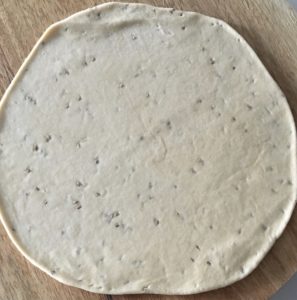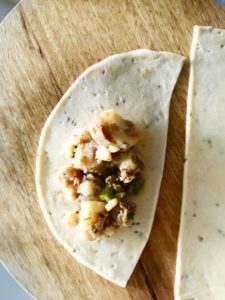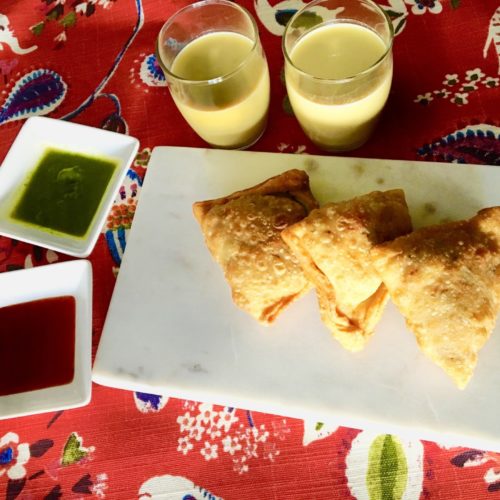
Aloo Matar Samosa (Potato and Peas Pastry) is a popular street food from India. As with many Indians, it’s my favorite snack too with hot cuppa masala chai and cilantro chutney!
What are Samosas?
Samosas are fried, baked pastries with a savory filling such as potatoes, peas, onions, carrots, lentils, etc. Traditionally, the filling is vegetarian, but the meat variants are popular too. Red and white meat fillings are dominant as well.
The size and fillings may vary but the shape is distinctly triangular!
History
So do Samosas have a story to tell? This unassuming heartthrob of many Indians across the globe, isn’t originally Indian! You read it right.
It travelled great distances from Egypt to Libya to Central Asia and finally reached the Indian subcontinent. The name ‘Samosa’ is derived from the Persian word ‘sanbosag’. During the Mughal rule, the traders from Central Asia introduced the ‘travel snack’ to the Indian royalties. It was then quickly absorbed in the royal cuisine and accepted by the locals as well.
The early accounts of this snack in India were meat filled. ‘Hyderabadi Lukhmi’ is a popular samosa variant from Hyderabad. Since Indian food habits are predominantly vegetarian, it wasn’t long before that samosa got a vegetarian version. The aloo matar (Potato Peas) samosa is a popular street snack in India ever since.
You may also like: Hyderabadi Lukhmi, Vegetable Bullets
Nutrition
The ingredients of a samosa may vary and these ingredients determine it’s final nutritional facts.
As we all understand, a vegetarian version would be healthier than a meat version of a samosa. Vegetables provide more nutrients and minerals with less calories and saturated fats.
The samosa crust also has a contribution. Ideally, for a crispy and flaky crust, butter or oil is added which increases the fat and calorie levels.
Additionally, the triangular snack is fried, which further increases the fat content.
Rule of nature, ‘Too much of anything isn’t good for the human body’. As with any food or ingredient, samosa too, if made correctly and consumed in right proportions isn’t unhealthy.
My Story….
Aloo matar Samosas have always been my favorite snack/ appetizers since childhood. It was one of those street foods that I can’t resist, even to this day.
After all these years of my foodie life, my sensory system is now well trained to recognize a perfectly fried, crisp, flaky samosa just by it’s exterior!
My love for samosas is ever since my early food memories. It was one food that I remember, we girls had without any fuss. The hot potato peas filled triangular pastry dunked in hot and sweet tomato sauce and green cilantro chutney….yumm! It’s always been my evening food fantasy.
My mom’s tradition of making Samosas at home were for 2 Hindu festivals: ‘Holi’ (Festival of colors) and Janamasthami (festival that marks the birth of Hindu God, Lord Krishna). As kids, we 3 sisters had different roles to play while she made samosas. The joy and excitement of getting to eat them used to glue us to the ‘kadhai’ (frying pan)! ☺
Mom’s cooking traditions has always been an important factor in framing my food memories.
Even to this day, I associate ‘Holi’ to a day of fun and frolic, playing colors with family and friends. Tired and hungry, we always looked forward to hot samosas, thandai (Indian cold drink with milk) and puran polis (Maharashtrian sweet bread)!





Enough said, sharing ‘Aloo matar samosa’ recipe that is an improvised version of my mom’s recipe. Hope you get to make it and enjoy!

Aloo Matar Samosa (Potato and Peas Pastry)
Ingredients
For the samosa pastry
- 1 1/2 cups All purpose flour
- 1/2 cup Whole wheat flour
- 3-4 tbsp Ghee or butter or any cooking oil
- 1 tsp carom seeds or 'ajwain'
- Salt to taste
- Water as required for kneading
For the filling
- 2 medium sized Yukon gold Potatoes
- 3/4 cup Green Peas
- 1-2 nos Green chili chopped
- 1/2 tsp Cumin seeds
- 1 tsp Ginger paste
- 1/2 tsp Red chilli powder
- a pinch Asafetida or hing
- 1/2 tsp cinnamon
- 1 tsp Cumin
- 1 tsp coriander
- 1 tsp Fennel seeds crushed to powder
- 1/4 tsp Black pepper
- 1 tsp cardamon pods crushed to powder
- 2 tsp 'Anardaana' or dried mango powder or lemon juice
- 2 tbsp Cilantro chopped for garnish
- Salt to taste
- oil for frying
Instructions
For the pastry
- In a medium mixing bowl, take the all purpose flour, wheat flour, salt and carom seeds and mix well. Next add ghee (or butter or oil) and mix well.
- The ghee should be rubbed well in the flour, so that the flour should bind together (without water).
- Now add water (in batches) to knead the flour firmly.
- Cover the dough with a moist cloth for 30-40 minutes before using.
For the filling
- Peel and chop the potatoes into 1/2 inch cubes.
- Steam or boil the potatoes cubes and peas until cooked completely.
- Heat a tbsp of cooking oil in a non stick pan and add cumin seeds. Once they sizzle, add ginger paste and cook for 30 seconds or until the raw aroma of ginger disappears.
- Next add asafetida, red chili powder, green chilis, peas, cinnamon powder, cumin powder, coriander powder, fennel powder, black pepper powder, cardamom powder and anardaana powder.
- Give them a quick mix and add the boiled potato cubes and salt. Mix, so that the spices evenly coat potatoes. Add chopped cilantro and remove from heat. Keep them aside and let it cool.
Shaping, stuffing and frying samosas
- Now take the dough and divide them into 8-9 equal dough balls.
- On a lightly floured surface roll the dough ball with a rolling pin to get a 1/2 inch thick round circle.
- With a paring knife, cut the center of the circle into two equal halves.
- Apply water on the straight edge of the circle half and form a cone.
- Fill the potato and peas filling in the cone and seal the cone edges.
- Repeat the same for the remaining dough balls.
- In a ‘kadhai’ or frying pan, heat sufficient oil for frying.
- Once the oil is hot, on a high flame, slide the samosa and quickly reduce the flame to medium.
- Turn the samosas in between and fry until golden brown.
- Drain excess oil on an absorbent tissue paper.
- Fry samosas in batches and follow the same procedure.
- Serve them hot or warm with cilantro chutney, tomato sauce or tamarind chutney. Enjoy!
Notes
- Instead of frying, you can bake as well. Bake at 180 degree celsius or 360 degree fahrenheit.


Leave a Reply